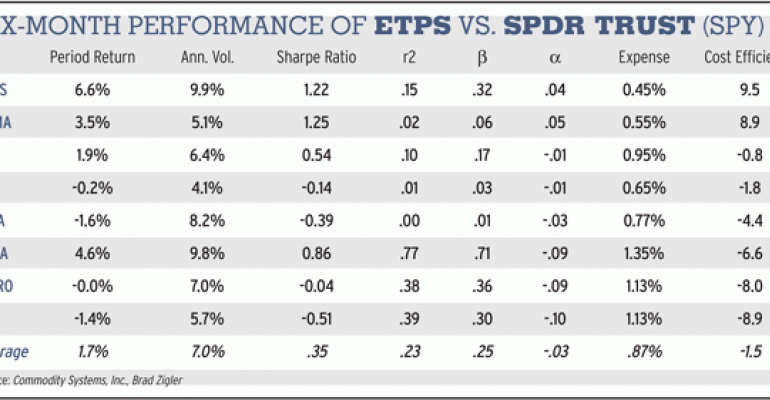Forget what you hear about gold and silver being rare commodities. Far more precious than metals is that holy grail of money management -- alpha. The cost of acquiring market outperformance -- or, more properly, the cost of acquiring the opportunity to earn it -- is well known to accredited investors. Perhaps too well known. A “two-and-twenty” arrangement -- two percent annual management fee and 20 percent of new profits -- is commonly charged by the hedgies. Pretty expensive stuff, that alpha.
A primary objective of hedge funds, of course, is to hedge -- that is, to carve alpha away from beta, if possible. With that in mind, we can balance the effectiveness of a hedge fund in holding down beta while striving for alpha. All this comes at a cost, so investors need to be mindful of the expense involved when shopping for non-correlated outperformance. A simple way to distill a hedge fund’s cost efficiency into a single value is to divide the product’s alpha by its expense ratio.
The cost of alpha is being brought down by a new generation of hedge-fund-like exchange-traded products. At least that’s what the marketers of these products say. These are early days for alpha-seeking ETPs, so we have rather limited data to test against their sponsors’ pitches. Still, the first-semester report card on eight products offers some telling insights into alpha’s new cost structure.
Among the ETPs with six-month track records are:
- ALT - The iShares Diversified Alternative Trust holds financial futures together with currency forwards and attempts to produce absolute returns uncorrelated to traditional asset classes. In the past six months, the ALT fund has succeeded in keeping its beta trimmed to 17 percent vs. the investable version of the S&P 500 Composite (SPY), producing a return modestly short of the 2.5 percent inflation in the Consumer Price Index. ALT’s annual sponsor fee is 95 basis points.
- CPI - CPI, the IQ Real Return ETF, explicitly sets the realization of an above-inflation return as its goal. CPI is a fund-of-funds that holds a diverse mix of exchange-traded equity, fixed income, currency and commodity portfolios. CPI’s barely negative six-month return fell short of its inflation target, while the fund’s beta was tamped down to just three percent. The fund’s expense ratio consists of a 48-basis-point management fee, plus a 17-bps pass-through of costs from the underlying ETFs.
- CSLS - Credit Suisse AG’s Nassau branch is the issuer of the Credit Suisse Long/Short Liquid Index ETN which tracks the aggregate performance of a universe of long/short equity funds. A low (15 percent) beta, coupled with a positive alpha (4 percent) and a modest sponsor fee (45 bps) makes this note the stand-out performer for the past six months. The trade-off? Investors assume counterparty risk to the Aa1-rated financial institution.
- CSMA - Another note issued by the Nassau branch of Credit Suisse AG, the Credit Suisse Merger Arbitrage Liquid Index ETN, replicates the returns generated by an index of publicly announced merger and acquisition transactions meeting certain qualifying conditions. CSMA’s correlations to the S&P 500 portfolio are even lower than CSLS’s, but its higher sponsor fee put the note in the second-best slot despite a higher alpha coefficient.
- GTAA -This portfolio engages in a momentum-following tactical asset allocation scheme using a diverse mix of ETFs. The underlying funds’ carrying costs add 45 basis points to GTAA’s 90-bps management fee, making this fund the most expensive of the lot. The fund also has the highest correlations to SPY, but still underperformed the blue-chip stocks over the last semester.
- MCRO - The IQ Hedge Macro Tracker ETF is another fund-of-funds that attempts to replicate the risk-adjusted returns of hedge funds pursuing macro and emerging market strategies. The fund also utilizes ETFs to fulfill its mandate, so their embedded costs push MCRO’s expense ratio up from 75 bps to 113 bps. That, coupled with the portfolio’s negative alpha, made MCRO one of the costliest funds over the past six months.
- MNA - Like CSMA, the IQ Merger Arbitrage ETF attempts to track the returns of hedge funds specializing in mergers and acquisitions. MNA has the lowest correlation to the S&P 500 fund, but its weak relative return renders middling cost efficiency.
- QAI -The IQ Hedge Multi-Strategy Tracker ETF is well named. Without actually owning hedge funds, this portfolio attempts to mimic the returns of an index tracking multiple investment styles, including long/short equity, global macro, market neutral, event-driven, fixed income arbitrage, and emerging markets. This fund-of-fund uses exchange-traded funds as portfolio building blocks and passes on an additional 38 bps on top of its baseline 75-bps management fee. The amalgam approach produced a fairly substantial correlation to SPY, but not a positive return, making QAI the least cost-efficient product in our universe.

As you can see from the table, only two products, the Credit Suisse notes, exhibited positive alpha over the past six months. The absolute return portfolios -- ALT and CPI -- turned in the next-best performances, largely because of their lower volatility.
Keep in mind that alpha reflects annualized risk-adjusted returns, not absolute performance. You’re comparing an ETP’s return to that of the beta-adjusted SPY.
To boot, we’re extrapolating a full year’s return from six months of actual performance. These statistics may look quite different six months from now when a full year’s performance is considered.
If there’s one thing we can take away from this exercise, it’s this: It’s a lot easier to beat the beta bogey than it is to earn alpha.






